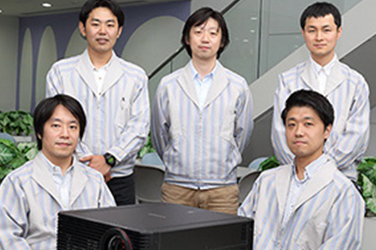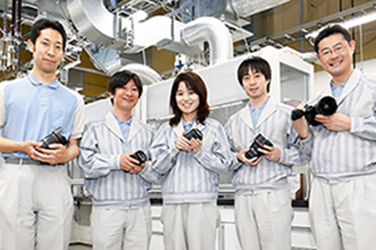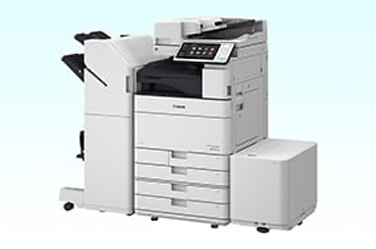Technology in ProductsProjectors
Projectors and the technologies within are more widely used than ever
Projectors can be flexibly adapted to whatever media need to be projected. This is why projectors are used in such settings as conference rooms and classrooms as well as for a wide range of purposes including product descriptions in stores and sporting events.
Canon’s projectors project a bright, high-resolution image to all four corners of the projection screen. Our unique optical system and lens technologies facilitate ease of use and deliver beautiful images.
May 11, 2023
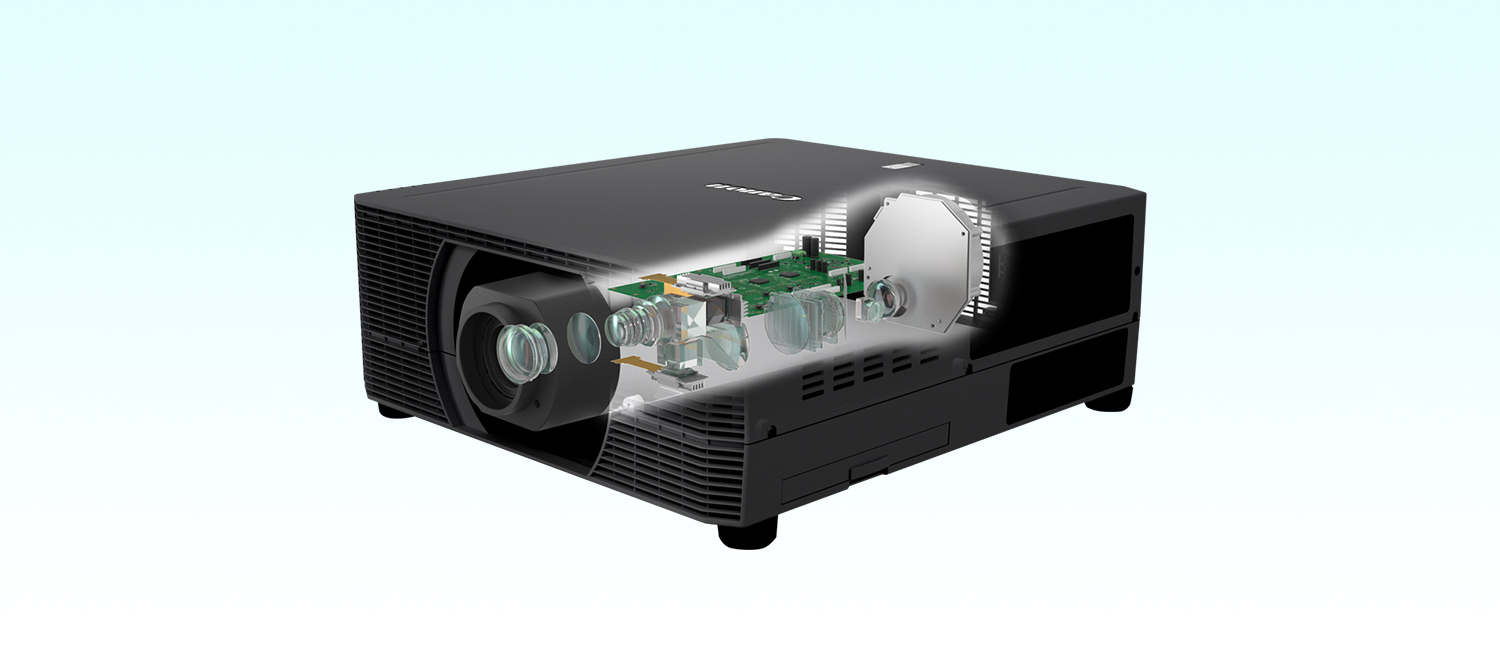
How projectors work
A projector consists of a light source, an illumination optical system, a color separation / combination optical system, a liquid crystal panel, and a projection lens. Light emitted from the light source passes through the illumination optical system, is transmitted through or reflected off the liquid crystal panel, and is magnified by the projection lens to project an image.

Read More
Canon’s projector technology
Thanks to the reflective liquid crystal (LCOS) panel, proprietary optical system, AISYS and lens technology developed over the company’s long history, Canon’s projectors project bright, high-resolution, and beautiful images even in the periphery of the large screens they project onto. A wide range of models are available for different uses and environments, in order to meet the needs of customers. These include models with a laser light source and a long life of approximately 20,000 hours, high-spec models such as 4K models, and ultra-short-throw models that are appealing because they take up less space.
AISYS
Canon uses the reflective liquid crystal (LCOS) panel as the image display element in its flagship projectors. The LCOS panel is used in combination with a polarizing beam splitter (PBS), which is an optical element that divides light into reflected and transmitted light depending on the direction of polarization. To achieve a high contrast, light should ideally enter the LCOS perpendicularly at an angle of 45 degrees relative to the polarization and separation surface of the PBS. However, this would result in a longer focal length and a unit larger in size. To overcome this problem, Canon developed its proprietary optical system, AISYS. AISYS consists of an “illumination optical system” that controls the light from the light source and a “color separation / combination optical system” that separates and combines light into the three primary colors of RGB before sending it to the projection lens.

AISYS’ optical light source system uses a lens system with different refractive indices in the vertical and horizontal directions to consolidate light from the light source. Luminous flux in the horizontal direction is consolidated at a large angle to increase luminance. Luminous flux in the vertical direction is consolidated at a narrow angle to prevent light leakage that occurs in a PBS or LCOS, thereby helping to increase contrast and making possible a smaller device size.
The color separation and composition optical system, which allows light to enter the projection lens as an image, separates light from the illumination optical system into the three primary colors of RGB and then directs the light into the dedicated LCOS for each color. The reflected light from each panel is then appropriately combined. In general, the LCOS system divides the light from the light source into three paths for the three primary colors, RGB, while Canon’s color separation and composition optical system divides the light into two paths, R+B and G, thus reducing the size of the optical unit and accordingly, the size of the projector itself.
Real 4K high resolution
There are two types of methods of achieving 4K high resolution*1, “Shift 4K”*2 and “Real 4K.”
Shift 4K is a technology that uses a panel with a 2K resolution*3, but it pseudo-divides the pixels by shifting the projected light at high speeds to project an image at 4K resolution. Although this technology provides a more realistic image than 2K resolution, finer details may be blurred due to the pseudo-division of pixels.
In contrast, real 4K panels can be larger in size, depending on the type, resulting in larger projectors. However, Canon’s LCOS allows for a compact panel. In combination with Canon’s unique AISYS optical system, real 4K panels can display high-resolution images while maintaining a compact and lightweight form.
Canon’s flagship model uses a real 4K panel and a unique projection lens optimized for the panel, enabling high-resolution projection of even the smallest details.Canon helps customers to achieve more realistic and immersive visual expression.
*1: 4K resolution: There are various standards such as 4K UHD (3,840 x 2,160) and Real 4K (4,096 x 2,160).
*2: The terminology differs depending on the manufacturer.
*3: 2K resolution: There are various standards such as FHD (1,920 x 1,080), WUXGA (1,920 x 1,200), and WQXGA (2,560 x 1,600).
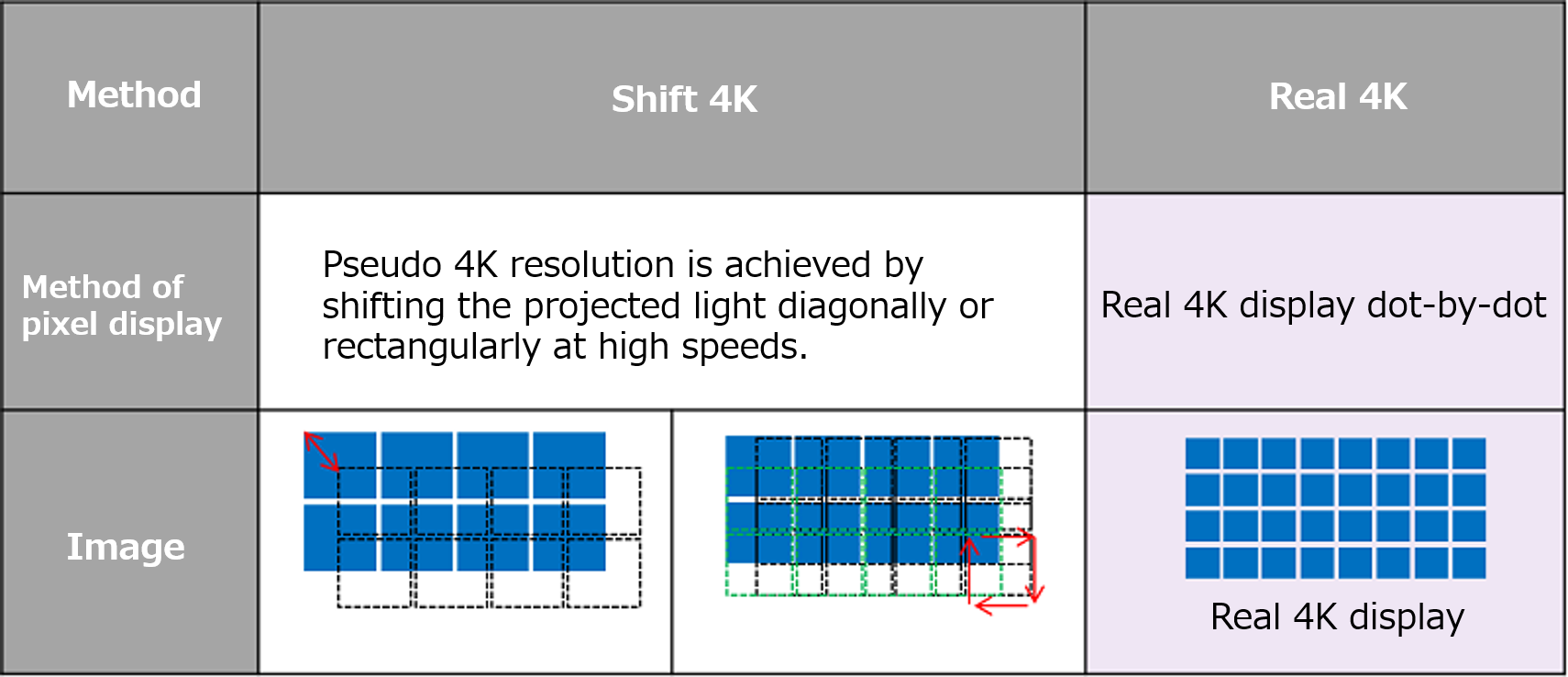
Dedicated lenses
Canon’s projector lenses are the result of a fusion of its more than 40 years of lens development, and the latest technologies, inheriting the excellent optical performance of EF and RF lenses widely praised in the camera industry. Canon’s projector lenses provide outstanding color reproduction, high resolution, high contrast, and image quality that is sharp, clear, and vivid. In addition, overall reliability, including quality, precision, strength, environmental resistance, and operational durability, are thoroughly considered right from the design stage.
UD lenses
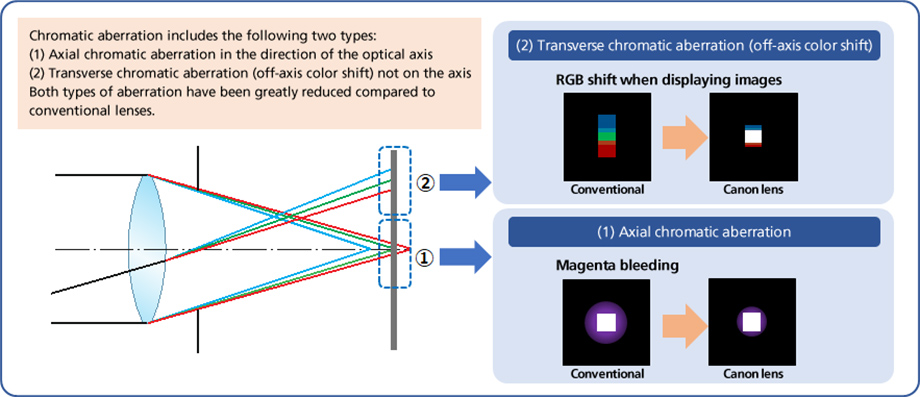

Since the refractive index of RGB light passing through a lens differs depending on its wavelength, color blurring, or what is known as “chromatic aberration,” occurs when projecting an image onto a screen. Chromatic aberration includes axial chromatic aberration in the direction of the optical axis and off-axis transverse chromatic aberration (off-axis color shift).
For high-resolution 4K images, further steps had to be taken to correct chromatic aberration.
Canon has succeeded in suppressing chromatic aberrations that occur in projectors by using ultra-low dispersion (UD) lenses that produce less chromatic aberration.
Floating lens system
The optical performance of a typical projector varies depending on the projection distance. Aberrations tend to occur particularly often when projecting images at short distances.

Canon’s projectors use a floating system that minimizes aberrations by moving multiple lens groups independently during focusing.This system enables projection of a high-resolution image at all projection distances.
Peripheral focus correction (marginal focus)
This function, available with Canon’s 4K projectors, corrects image curvature that occurs when projecting an image onto a curved surface, such as a domed ceiling. Focus adjustment brings the four corners of the image projected on the curved surface into focus. Combined with the lens characteristic of a deep depth of field, this feature enables projection of high-resolution images in which every corner of the large screen is in focus.
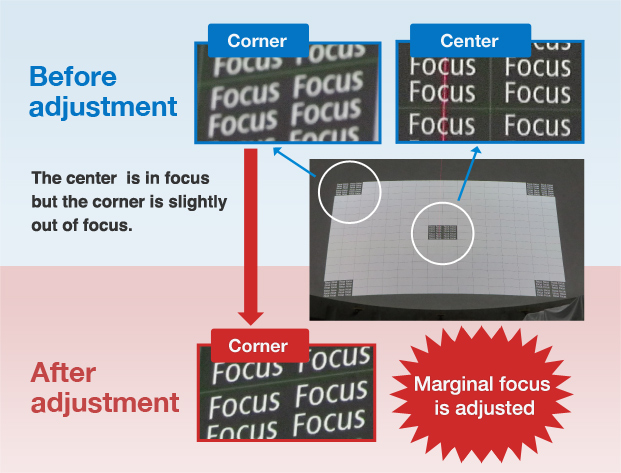
A lens with a short throw and a high shift
・Short throw
A short throw and wide lens shift allow an image to be projected onto an entire wall from the ceiling, even in narrow spaces such as museums and retail locations.


・High shift mechanism
This feature allows the projection screen to be shifted vertically and horizontally without tilting the main unit via a mechanism that shifts the projection lens in parallel.


The combination of a short throw and high shift, which are notable features of Canon’s projection lenses, enables projection on a large screen at a short distance and ease of use during presentations.










